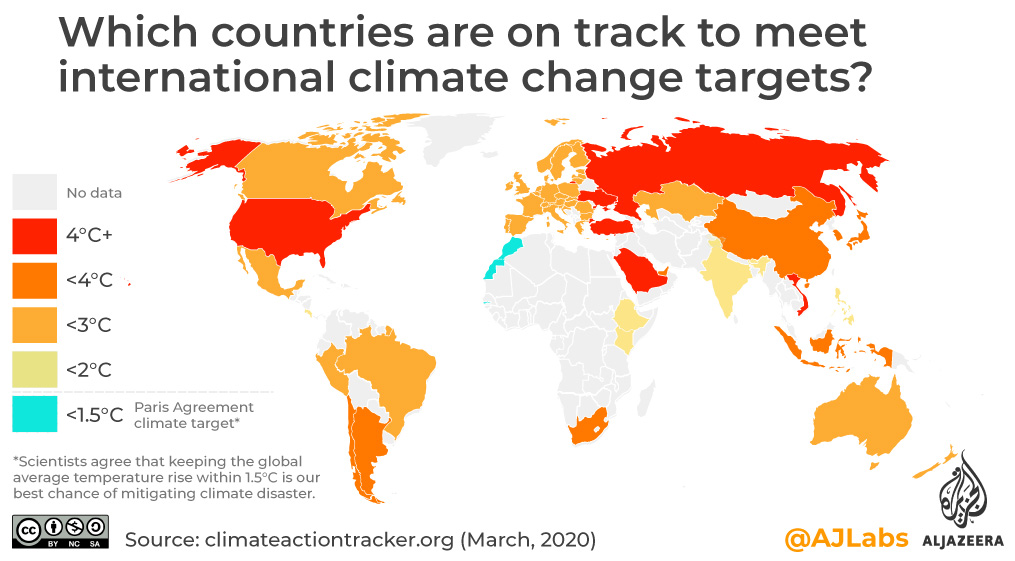As oil slumps, Norway explores new fields in the Arctic
Oil giant BP cuts billions of dollars from the value of its assets as Norway continues to export its carbon emissions.
![Illustration: The Green Read - June 18 [Jawahir al-Naimi/Al Jazeera]](/wp-content/uploads/2020/06/70277b9b6aa643758d1770e32cc2d895_18.jpeg?resize=770%2C513&quality=80)
The big environmental news of the week is unexpected and, in a planetary sense, encouraging.
Oil giant BP slashed $17.5bn from the value of its oil and gas assets, warning of the enduring impact of the COVID-19 crisis, which it expects will accelerate the shift away from fossil fuels.
Keep reading
list of 4 itemsMelting glaciers, rising seas: Approaching climate tipping points
The climate crisis: Preparing for what’s already here
The US is back in the climate fight
Reducing carbon emissions to net zero by 2050 is a core element of the Paris Agreement to stop runaway climate change.
“We have reset our price outlook to reflect that impact and the likelihood of greater efforts to ‘build back better’ towards a Paris-consistent world,” said BP chief executive Bernard Looney, who assumed his role in February.
The paradox of COVID-19 is that despite the misery it has wrought, it does present a tremendous opportunity for governments to revive their economies in a climate-friendly way, which could force a whole load of oil and gas to be left in the ground, as renewables take over the global grids.
And it seems this is how Looney sees the future. Earlier this year, he promised BP would invest more in clean energy and less in fossil fuels over the next 30 years.
Of course we must apply a generous sprinkling of scepticism to the pronouncements of an oil giant. Only when the drilling actually stops can you be sure of the company’s commitment to shrinking its carbon footprint to zero.

Norway continues exploring
But the move does make you look askance at Norway. This week, MPs in the super-rich oil nation are expected to vote against further protection of one of the world’s most important biological hotspots, so enabling continued exploration in the Barents Sea.
This comes off the back of a pledge to delay more than $10bn in taxes for petroleum companies, to spur investment which will help fund drilling in a uniquely biodiverse area called the marginal ice zone.
This is where Arctic sea ice meets the open ocean and where phytoplankton and fish, polar bears and birds, seals and whales, have thrived for millions of years. Now the zone is threatened as shrinking sea ice tempts the oil prospectors with the potential of untapped reserves. And the government is ushering them in through an open, dollar-lined door.
The criticisms are many. Dr Peter Winsor, WWF Arctic Programme director said: “By ignoring science, Norway is failing to provide global leadership on climate change and placing oil profits before nature.”

But then Norway is environmentally at odds with itself.
You have the oil that made it one of the richest nations on earth. Then walk around Oslo and you will see electric cars all over the place – in fact, three out of four cars now sold in Norway are either wholly or partially electric.
And 98 percent of Norway’s electricity comes from renewable energy, of which hydropower is the main source. The nation talks highly of its own sustainable prowess. And well it might.
But all those fossil fuels Norway extracts? They go overseas. The nation may not emit too many greenhouse gases, but it exports them on a colossal scale. Norway’s wealth is someone else’s smog.
You do wonder though, given BP’s stated position, for how much longer?
How much of your country’s electricity comes from clean energy sources?
Your environment round-up
1. Coal: As electricity demands decline amid the coronavirus pandemic, and cheaper renewables attract investors, some energy experts are predicting a possible end to coal, the most polluting of all fossil fuels.
2. Endangered turtles: Watch tens of thousands of endangered green turtles swim to their nesting grounds on Raine Island off the coast of northeastern Australia. The drone footage, first recorded in December 2019 and released this month, captures the “world’s largest aggregation of green turtles”.
3. Brazil: Members of the Kambeba tribe in the Amazon rainforest explain how they used both Western and Indigenous medicines to tackle a COVID-19 outbreak in their communities.
4. Insects: Scientists sound the alarm as insect populations – key to our survival – continue to rapidly decline.
5. Cities: As residents continue to enjoy cleaner air amid the pandemic, cities like Mexico City, Copenhagen, and Los Angeles are working on ways to keep their skies clear.
The final word
As yet the wind is an untamed, unharnessed force, and quite possibly one of the greatest discoveries hereafter to be made will be the taming and harnessing of it.